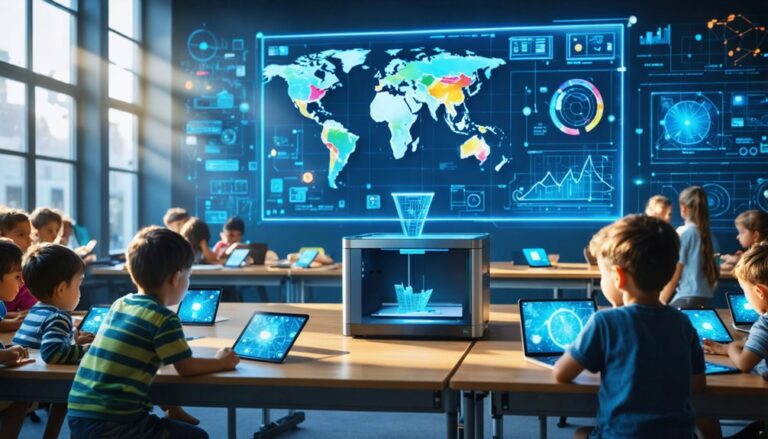Top digital tools for modern classrooms include Learning Management Systems (LMS), Artificial Intelligence applications, immersive technologies like virtual reality, and interactive classroom hardware. Accessibility and inclusion technologies guarantee equitable learning for students with disabilities, while communication platforms enhance collaboration among teachers, students, and parents. Data analytics tools track student progress and inform instructional strategies. Additionally, gamification and virtual labs promote engagement and experiential learning. Exploring these tools can further uncover their groundbreaking potential in education and help to revolutionize the learning experience.
Highlights
- Learning Management Systems (LMS) streamline education by providing accessible platforms for course materials, quizzes, and communication between students and teachers.
- AI-driven personalized learning tools enhance student engagement and outcomes, tailoring educational experiences to individual needs and learning styles.
- Immersive technologies like virtual reality offer interactive and engaging learning experiences, enabling unique explorations of complex subjects and environments.
- Assistive technology, including screen readers and text-to-speech applications, supports students with disabilities and promotes inclusivity in the classroom.
- Interactive displays and tools, such as SmartBoards, facilitate multimedia integration and enhance lesson delivery through interactive quizzes and educational games.
Learning Management Systems
Learning Management Systems (LMS) have emerged as essential tools in modern education and corporate training environments, revolutionizing the way knowledge is delivered and acquired. The global LMS market is projected to reach $70.83 billion by 2030, evidencing significant LMS adoption across various industries. Currently, 83% of organizations leverage these learning platforms, with tech companies and educational institutions leading the charge. As online learning gains traction, 70% of students say online classes are better than traditional classrooms, and 75% of K-12 schools are expected to implement LMS by 2025. Moreover, employees experience improved training efficiency and retention rates, underscoring the effectiveness of digital learning. As the adoption of LMS continues to rise, AI-powered personalization is transforming education through tailored learning experiences. Additionally, organizations that invest in comprehensive training programs have 218% higher revenue than those that don’t invest. Embracing these innovative solutions promotes growth and community, connecting learners and organizations in a vibrant educational landscape where everyone can thrive together.
Artificial Intelligence Tools
As educational environments evolve, Artificial Intelligence (AI) tools are increasingly becoming integral to enhancing the learning experience. With a projected market value of $7.57 billion by 2025, AI applications support both students and teachers alike, with 86% of educational organizations emphasizing active implementation. Research shows that personalized AI learning can improve student outcomes by up to 30%, while engagement levels soar ten times higher than traditional methods. Moreover, intelligent systems aid in rapid feedback and identifying knowledge gaps early. A significant 64% of students leverage AI for tutoring, reflecting its pervasive role in academia. Additionally, personalized AI learning has been shown to help students achieve 70% better course completion rates, highlighting its impact on educational success. Furthermore, AI literacy is becoming a crucial aspect of modern education as both students and teachers require training to understand and effectively utilize these tools.
While leveraging this technology, institutions are also recognizing the need for clear guidelines to ensure responsible use of AI tools, fostering an environment that enhances academic integrity and critical thinking. As institutions adopt formal AI guidelines, the potential for inclusive, adaptive learning continues to expand, cultivating a sense of community and belonging among learners.
Immersive Technologies
Immersive technologies, embodying innovations such as virtual reality (VR) and augmented reality (AR), are revolutionizing educational structures by offering energetic and interactive learning experiences. Projections indicate that the global immersive technology market in education will leap from $7.52 billion in 2024 to $76.82 billion by 2035, showcasing a staggering growth path. VR has revolutionized learning environments, enabling virtual field trips to historical sites and enhancing medical education through 3D anatomical explorations. With over 75% of Fortune 500 companies using VR for training and education, interest in immersive technologies is palpable, indicating a future substantially shaped by these tools. As schools adopt immersive technologies, they create inclusive, engaging, and effective learning spaces that nurture a sense of belonging among students. The market was valued at approximately $92.61 billion in 2023, indicating significant expansion in just two years. Furthermore, these educational outcomes are enhanced through innovative digital learning design that supports diverse learning preferences.
Interactive Classroom Hardware
Interactive classroom hardware is at the forefront of educational technology advancements, fundamentally revolutionizing teaching and learning experiences. The integration of interactive displays, such as SmartBoards and Promethean’s ActivPanel, has become prevalent, with 78% of educators using these tools in K-12 classrooms. This hardware allows for seamless connectivity and multimedia integration, enhancing lesson delivery through quizzes and educational games. Non-OS displays now enable software updates without hardware replacement, promoting sustainability and effective technology management. With schools requesting interactive screens without operating systems, the need for easy upgradability is emphasized, allowing educators to adapt their tools to evolving educational needs. With educators acknowledging the necessity of digital makeover for improved teaching, the adoption rates reflect a growing trend—especially notable in regions like the UK and the Netherlands, which boast low student-to-whiteboard ratios. Ultimately, classroom hardware nurtures inclusive and engaging learning environments for all students. Notably, the global interactive whiteboard market was valued at USD 4.2 billion in 2023, highlighting the significant investment in these technologies. Furthermore, this interactive hardware aligns with the goal of enhancing student engagement, ensuring that learners remain motivated and actively involved in their education.
Accessibility and Inclusion Technologies
While educational advancements continue to reshape the terrain of modern classrooms, accessibility and inclusion technologies play a critical role in ensuring that all students, regardless of their abilities, can engage meaningfully with the curriculum. Assistive Technology, such as screen readers and text-to-speech applications, enhances access for students with disabilities, substantially improving learning outcomes. Remarkably, Microsoft’s Immersive Reader supports dyslexic students while benefiting all learners. Despite these advancements, a 2023 survey revealed that only 7% of users with disabilities felt that current digital tools sufficiently addressed their needs. Additionally, inadequate teacher training and resource allocation gaps hinder effective integration. Importantly, 84 percent of teachers say it’s impossible to achieve equity in education without accessible learning tools. Emerging technologies are being used to support inclusive teaching practices and enhance the educational experience for students with disabilities. Furthermore, inclusive education fosters collaboration and empathy, which enhances the overall learning environment for all students.
Communication and Collaboration Platforms
In modern educational settings, communication and collaboration platforms have emerged as essential tools that facilitate seamless interaction among students, teachers, and parents. Platforms like Microsoft Teams for Education and Google Classroom embody effective collaboration strategies, integrating chat, video conferencing, and assignment management with user-friendly interfaces. Schools are increasingly adopting personalized communication protocols, utilizing AI-driven systems to deliver targeted updates that harmonize with specific audiences. Additionally, the emphasis on personalization ensures that updates are not only relevant but also resonate with the unique needs of each community member. Meanwhile, tools like Slack and Edmodo promote vibrant discussions and social learning, enhancing parent engagement. As these platforms support efficient workflows and prioritize secure data management, they enable educators and nurture a sense of belonging within the school community, making collaborative learning more inclusive and efficient than ever. The integration of collaborative technology ensures that all members of the educational community are engaged and accountable in the learning process. Moreover, collaboration has gained importance in the learning process, fostering interpersonal skills and deeper understanding among students.
Data Analytics and Outcome Measurement Tools
Data analytics and outcome measurement tools have become vital in revolutionizing educational practices, enabling institutions to harness the power of data to enhance student learning experiences. These tools employ predictive modeling to identify students at risk of underperformance with impressive accuracy, facilitating early interventions. Learning analytics capabilities analyze LMS engagement data, tracking student progress and revealing knowledge gaps. Data visualization platforms like Power BI and Tableau enable educators to examine performance metrics interactively, nurturing a deeper understanding of learning outcomes. Data visualization tools provide instant insights into trends, allowing for timely strategic adjustments to teaching methods. As educational institutions increasingly adopt these tools, including AI technologies, they can refine instructional strategies and improve retention rates. Ultimately, these analytics pave the way for more personalized and effective educational environments, promoting a sense of belonging and achievement for all students. Additionally, combining these tools with cloud-based analytics solutions enhances collaboration across departments, streamlining data access and decision-making processes.
Gamification and Engagement Tools
Gamification has emerged as a revolutionary strategy in modern education, enthralling both educators and students alike. With an anticipated growth path, the gamification education market is projected to leap from $1.55 billion in 2025 to $18.63 billion by 2033.
Engaging tools such as Kahoot! and Duolingo leverage gamification strategies to deliver interactive quizzes and language challenges, respectively.
Research has shown that educational games in gamified environments can enhance knowledge retention rates by up to 90%, making learning both enjoyable and effective.
Moreover, by integrating competition and collaboration thoughtfully, educators nurture motivation without discouraging learners.
As technology evolves, gamification continues to shape the future of learning, creating inclusive, immersive experiences that harmonize with students everywhere.
Additionally, by effectively incorporating interactivity, educators can employ gamification to fuel student engagement, thus propelling the educational journey along a successful course.
Virtual Labs and Simulation Software
Virtual labs and simulation software have emerged as vital components of modern education, offering innovative avenues for experiential learning beyond the constraints of traditional classrooms.
These tools provide virtual benefits, enabling students to engage in lab simulations anytime and anywhere, substantially enhancing their motivation and academic performance.
Meta-analyses indicate that virtual labs yield substantial improvements in engineering education outcomes, promoting higher engagement levels.
While they cannot fully replace hands-on experiences, they effectively compensate for existing limitations, facilitating repeated practice of complex procedures.
However, disparities in access and technology remain challenges.
Ultimately, as haptic feedback and AI-driven guidance evolve, virtual labs promise to augment the educational terrain, nurturing a sense of belonging in scientific exploration.
References
- https://www.class.com/blog/2025-student-centered-lessons-and-new-trends/
- https://toptools4learning.com
- https://octoproctor.com/blog/top-trends-in-educational-technology-in-2025
- https://ijsi.in/wp-content/uploads/2025/07/18.02.049.20251002.pdf
- https://www.reframexr.com/blog/classroom-technology-in-2025-5-innovations-that-are-transforming-education
- https://www.teravisiontech.com/blog/the-future-of-learning-top-5-trends-in-educational-technology-to-watch-in-2025
- https://www.aiscreen.io/education/digital-technology-tools-learn-with-technology/
- https://www.ed.gov/sites/ed/files/documents/ai-report/ai-report.pdf
- https://elearningindustry.com/lms-top-trends-transforming-the-future-of-education
- https://programs.com/resources/lms-statistics/



